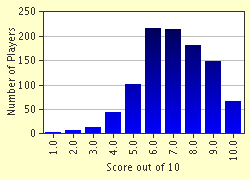Quiz Answer Key and Fun Facts
1. It is 1943. You have been transported by railway freight car to a concentration camp near your native Krakow. As you get off the train, you see a sign above the main gate reading "Arbeit Macht Frei". What does this sign literally mean?
2. You are taken to a building where you are given a brief medical examination. After providing your personal information, you are tattooed on your left forearm with a five-digit number. What camp must you be at to receive this treatment?
3. You are interned with many other prisoners, each wearing a characteristic striped uniform. When you report to work at the nearby synthetic rubber plant, you see many people with a large yellow six-pointed star on their left breast. How have the SS identified these people?
4. You see one prisoner wearing a red triangle instead of a yellow star. What is the significance of this?
5. You see one group of prisoners wearing purple triangles. They seem very anxious to speak with other prisoners, even when harshly disciplined for such activities by the SS. A fellow prisoner nudges you, saying "They could all get out if they wanted to!" Why are these prisoners here?
6. You see other prisoners wearing a blue triangle. These prisoners seem different from other prisoners, however, in that they appear to speak a plethora of different languages. You hear what sounds like French, Spanish, English, or Portugese; what German you do hear is halting and broken. What does the blue triangle designate?
7. You also see prisoners wearing green triangles. You further notice that they are shunned even by other prisoners. Who would be assigned a green triangle?
8. In one section of the camp, you see a group, separate from the others, wearing mostly black (and occasionally green) triangles. This is probably the Gypsy section of camp.
9. On occasion, you see male German prisoners wearing pink triangles. What does this triangle represent?
10. As you lay down in your bunk after your day in the camp, you cannot help but reflect on the irony of the slogan you saw the rank and file German soldiers wear before you were sent here. Proudly emblazoned on their belt buckles was the motto "Gott mit Uns" - "G-d is with us".
Source: Author
stuthehistoryguy
This quiz was reviewed by FunTrivia editor
bloomsby before going online.
Any errors found in FunTrivia content are routinely corrected through our feedback system.

